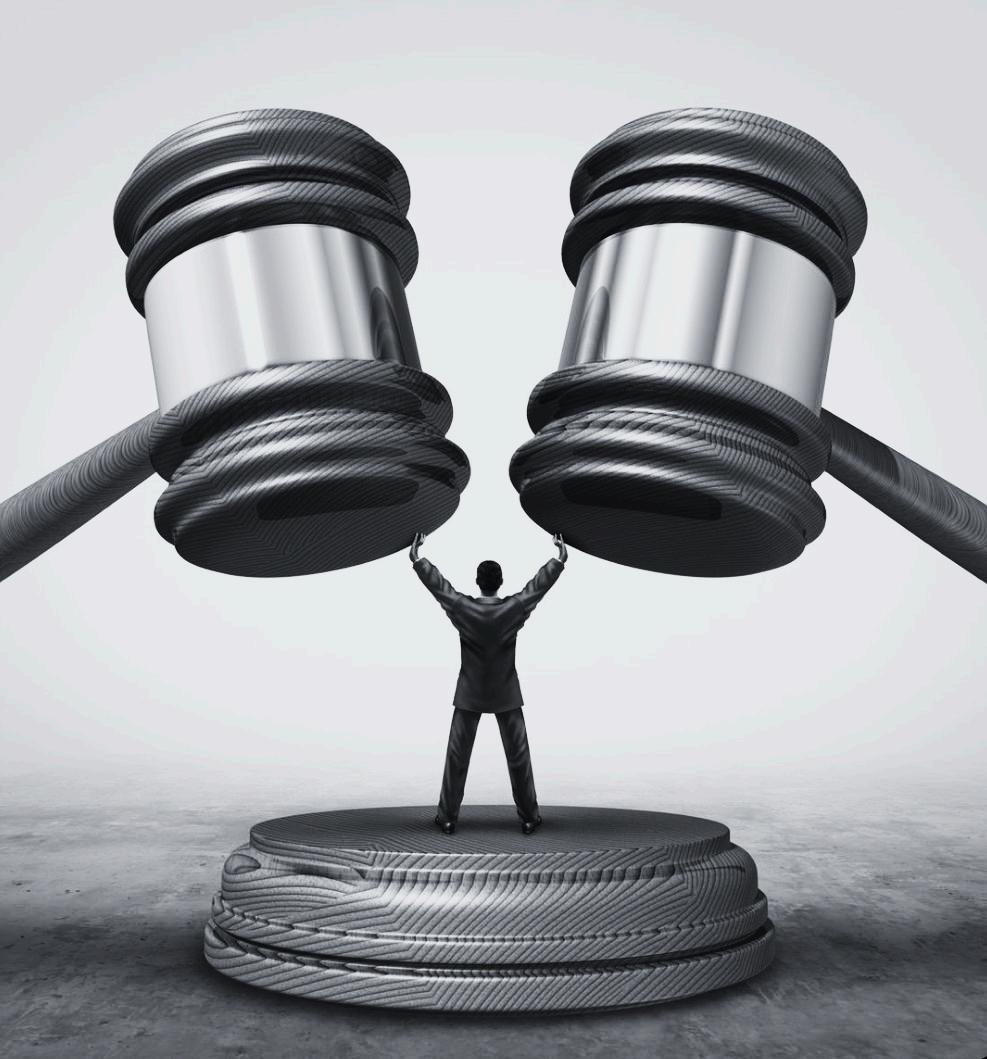Issue #8 Summer 2024


Issue #8 Summer 2024

Ethics is knowing the difference between what you have a right to do and what is right to doPotter Stewart
PAGE 4 - The SEC sues coinbase over listing unregistered securities: Is this the start of the end for crypto?
PAGE 7 - Legal Resilience: Preparing for Business Crises with a focus on the Boeing 737 Max Crisis


JOHNSON
In recent years, globally renowned healthcare, the reputable Johnson and Johnson company -
providing healthcare solutions to millions worldwide faced multiple lawsuits due to claimed connections between its talcum powder products and consequential adverse health effects, particularly ovarian cancer. The key allegations surrounding this case were the potential presence of asbestos, a known carcinogen, that presents a serious root of health risks including cancer and mesothelioma, in their talc-based products While J&J denies these claims, internal company documents revealed during litigation suggest they had adequate knowledge of the asbestos has stumbled onto a monumental crisis: the talc controversy A company with a history of

with the added weights of the allegations against them - scientific causations, questions about their “regulator compliance”, the mitigation of product safety concerns; attempting to produce nuanced perspectives - J&J has consistently claimed that their talc products (including baby powder) are safe and asbestos-free. The company stressed its harsh testing protocols and quality control measures to guarantee the safety of its products. According to J&J, any contamination found was low and within acceptable limits - challenging the investigation that found links between talc use and ovarian cancer and other health risks; presenting studies that showed that there was no definitive proof of a relation between talc powder and the claimed health risks.
Johnson & Johnson emphasized its compliance with administrative measures and endorsements - pointing out that its talc-based items went through thorough testing and had received endorsement from specialists, including the U.S. Food and Drug Administration (FDA). J&J argued that the warning labels and usage instructions on its talc-based products were sufficient and unambiguous and that any purported health problems were due to consumer misuse or noncompliance with the instructions.

The future of Johnson & Johnson talc, however, is still in murky waters. In an attempt to shield itself from future liability, J&J filed for bankruptcy under this entity, for, the management proposed an $8.9 billion settlement fund to resolve all outstanding lawsuits
The future of Johnson & Johnson talc, however, is still in murky waters. In an attempt to shield itself from future liability, J&J filed for bankruptcy under this entity, for, the management proposed an $8.9 billion settlement fund to resolve all outstanding lawsuits. However, this attempt was rejected by a federal appeals court due to apprehension about the legitimacy of the bankruptcy filing J&J also offered a 2 billion settlement to resolve talc-related investigations in 40 states but the proceedings were never finalized. The company stands by blaming the lawsuits and allegations it faces on misinformation and consumer disregard regarding talc safety.
The J&J talc case has had a lasting impact on consumer trust, corporate responsibility, and legal activism, regardless of the ultimate legal outcome waiting to happen It is a modern day example that presents as a stark reminder of the possible consequences of putting profit ahead of transparency and the power of group action in opposing powerful corporations.

IS THIS THE START OF THE END FOR CRYPTO?
BY: DHRUVA VENGALAIn 2008, a paper labeled “Bitcoin: A Peer-toPeer Electronic Cash System,” signed by Satoshi Nakamoto, was published. While the identity of Satoshi has never been revealed, his creation, Bitcoin, has exploded in value from a mere $0 0008 in 2010 to a massive all-time high of $71,000, ballooning initial investments into several multiples of themselves. While the attention of the ordinary investor has been fixated on the price of these virtual assets, the crack down by regulators on the wild west of cryptocurrencies has gone largely unnoticed From 2019, the SEC has been trying to implement stringent regulation on Virtual Digital Assets (VDAs). Recently a cryptocurrency exchange, Coinbase, has come under extreme scrutiny by the Securities and Exchange Commission of the United States for acting as the intermediary for soliciting the exchange of unregistered securities.
A lawsuit has been filed against Coinbase and the subsequent trial is now underway. The ongoing legal battle underscores the evolving landscape and challenges facing the cryptocurrency market as it strives for legitimacy and mainstream acceptance.

An exchange is an organized marketplace which matches buyers and sellers to trade a set commodity, security, derivative and other such assets. Exchanges make a business by taking a small cut from the value of each trade for acting as the intermediary In our case, Coinbase is one such exchange that offers cryptocurrencies as the assets to trade. There are over 200 coins and tokens listed on the exchange and the SEC only has to prove that any one of these is a security After listening to the arguments presented by the SEC, the judge has decided to solely focus on two coins namely Solana (SOL) and Chiliz (CHZ). In a scenario where the jury rules in favor of the SEC, all alleged securities will be delisted from American exchanges which might result in a massive blow to the market price of the delisted assets on other exchanges and markets. Action by the SEC may also prompt other regulators such as the European Securities and Markets Authority (ESMA) to take similar legal routes to delist the assets from European exchanges To really understand the lawsuit filed, we will first need to understand the definition the SEC uses to define what is and what isn’t a security.
The Securities Act of 1933 says a security is an investment in a business with an expectation of a profit from someone other than the investor. A swift glance at the definition might lead you to believe that cryptocurrencies are in no way a security; but the SEC disagrees The SEC has presented arguments stating that even though these tokens and coins are decentralized, the entity that developed the tokens still profits from the investment as the developing entity of these projects often holds a lot of the total supply of these tokens. One of the tokens alleged as being a security, Solana, had 20% of this initial supply allocated to the Solana Foundation that currently aims to contribute to growth in the Solana ecosystem and an additional 20% to the personal wallets of the team that initially worked on the project The SEC argued that such entities and individuals profit off the investments made into these tokens therefore making them a security. This ongoing debate highlights the complex legal and regulatory challenges surrounding the classification of cryptocurrencies, shaping the future landscape of digital asset markets.
The ruling might make or break the impending future of the crypto and web 3 space It thereby stands as one of the greatest barriers in the growth of the industry Proponents of these tokens argue that this is part of a massive conspiracy to curb the mass adoption of cryptocurrencies due to their untraceable nature. What does this mean for investors with large positions in these VDAs? According to Micheal Saylor, a big figure in the space and the founder of Microstrategy, the regulatory crackdown will eventually lead to many major tokens being delisted and handed the status of securities while only an elite class of assets such as bitcoin will be left being labeled commodities He urged investors to pull their money out of these alleged securities and move to safer options such as bitcoin. While others have questioned his intentions as his company also owns an approximated 1% of the total supply of bitcoin.
All in all, one thing one should take from this mess is that the underlying technology, the blockchain, that holds all these tokens in place and ensures their integrity remains From the early days, there have been skeptics criticizing every major invention of mankind from the wheel to the light bulb but eventually, the answer these inventions have presented to problems has led to their inevitable adoption. Will crypto follow the footsteps of the inventions that the world today cannot be imagined without or will it join the ever-growing pile of failed ideas? Only time will tell


The word “Legal Resilience” in today’s dynamic business world is not just a buzzword, but a critical aspect of ensuring business continuity and safeguarding against crises An illustration to demonstrate this is the Boeing 737 max crisis, an esteemed aviation manufacturer turned crisis-ridden reputed company, serving as a reminder to every business about the importance of proactive legal preparations. From the crisis, there are 5 fundamental learnings of legal resilience to take away
Firstly, one of the fundamental pillars of legal resilience to learn from Boeing's 737 Max crisis is the need for proactive compliance measures. In this case, questions were raised about Boeing's compliance with aviation safety regulations and its certification process for the 737 Max aircraft Businesses must ensure rigorous adherence to legal and regulatory standards by conducting regular audits and assessments to identify and mitigate potential compliance risks.
The most important lesson to be learned is that regulatory scrutiny is inevitable during a crisis. Following the 737 Max crashes, Boeing faced intense scrutiny from regulatory authorities, including the Federal Aviation Administration (FAA), regarding its safety practices and regulatory compliance Businesses must engage proactively with regulators, maintain open lines of communication, and demonstrate a commitment to comply to navigate regulatory challenges effectively. Businesses should be constantly in the phase of learning through criticism and implementing required changes to their models. Crises present opportunities for learning and continuous improvement. Boeing's response to the 737 Max crisis included implementing corrective actions, enhancing safety features, and improving pilot training protocols Businesses must conduct thorough post-crisis evaluations, identify lessons learned, and implement corrective measures to strengthen legal resilience and prevent future crises.
Legal resilience encompasses effective crisis communication and transparency, particularly in the face of legal and regulatory scrutiny. Boeing's initial handling of the 737 Max crisis was criticised for its lack of transparency and delayed communication with stakeholders
As a reputed aviation manufacturer, Boeing should have prioritised transparent communication with all parties involved in the conflict, providing timely and accurate information to regulators, customers, investors, and, most importantly, the public From this businesses must learn that fostering an atmosphere that stabilises tensions during a time of crisis – through implementing trust and credibility with people – is crucial. Adding to the same topic, building a culture of compliance that encourages accountability and ethical conduct ensures that legal and ethical considerations are integrated into the decision-making processes at all levels of the organisation. Legal resilience requires robust legal and ethical governance across all aspects of business operations In the aftermath of the 737 Max crisis, questions were raised about the ethical implications of Boeing's decision-making processes and its prioritisation of profit over safety: a puddle that no growing business wants to step in.

Contractual disputes - what are they? Contract disputes are something that most people have heard of, but they have a growing importance in today's day and age, with their number increasing dangerously. Contractual disputes are literally defined as when one or more parties disagree on terms, conditions, and definitions contained within a contract either while it is being drafted or while it is already signed by the concerned members The most common resolution to contractual disputes, and the one most people approach, is taking the case to court so that both parties can state their case in front of a judge. However, this is probably the least liked way of resolving any conflict because it is expensive as well as time-consuming, causing stress for both parties. There are a few other ways that people choose to solve contractual disputes; examples are negotiation, mediation, arbitration, as well as litigation None of these methods involve going to court and presenting arguments in front of a judge but are broadly more of a streamlined process.

parties are happy with the terms stated in the contract.
The definition of negotiation is to allow both parties to reach an outcome that is mutually liked. When we look at the word negotiation from a legal perspective, it means to come to an agreement on a set of legally binding terms, which is exactly what this method does. It takes into consideration the views of both parties, and the two parties attempt to come up with an end product that satisfies both of them There are mainly two types of negotiations used in contract dispute resolution - distributive negotiations and integrative negotiations. Distributive negotiations are where the two parties involved in a dispute give each other offers and counteroffers (usually in sharing a given resource), but in contractual resolution, the two parties make offers and counteroffers to one another until both Integrative negotiation is quite similar, but here the two parties are actively working together to create a win-win situation to come up with a working contract.
These two types of negotiation are the ones that are mainly used in a legal setting; however, there are other negotiation strategies that some see fit to use. Examples could include collaborative negotiation (which is what both distributive and integrative negotiation does - it needs both parties to collaborate and come up with a working solution). This type of negotiation is the most favorable; there is also competing negotiation in which one party is competing to get better terms in the contract

The legal considerations concerning negotiations are not steadfast since the main objective of negotiation is settling the dispute outside of court, but there are a few things that lawyers would advise both parties to follow. For example, if both parties or even one of the parties own a business, lawyers encourage them not to put any business-sensitive information into the contract while negotiating a dispute Lawyers of respective parties warn them to beware of bribery in all its forms; this means to look carefully at any offers made and observe word structure and blatantly refuse any bribes made. While settling a contractual dispute using negotiation, it is vital not to exaggerate terms or try to mislead the other party as this will create unrealistic expectations, and you would once again have to resolve that dispute. Most lawyers also think that it is important for the contract (once it is resolved) to get a second opinion - preferably from someone with a legal background An effective negotiation should often satisfy three main conditions The first one being that both parties should have one another's best interests at heart, and both must be willing to engage in active negotiation. The second one would be to deal effectively with the problem, which means to address the dispute at hand and work towards solving it instead of avoiding it. The third and final one would be to achieve a contract that satisfies both parties to a large extent
Another popular way of resolving contractual disputes is mediation - mediation is a form of settling disputes that is closely interrelated with that of negotiation, the only difference is that in mediation there is a third party that comes in to help the two concerned. The mediator must be completely unbiased and must help both parties equally.
To conduct mediation, both parties must be willing to do so and voluntarily participate in discussions regarding the problem The mediator does not give the two parties a solution but instead creates a conducive environment devoid of any heated arguments, yelling, or the use of explicit language so that both parties may receive the best results. There are mainly three types of mediation - facilitative mediation, evaluative mediation, and transformative mediation. Facilitative mediation is when the mediator allows both parties that are involved to make their own decisions so that the decision made will be highly sustainable Evaluative mediators are usually legal practitioners who are familiar with the law that is relevant to that particular dispute, and the evaluative mediator will provide their insights to both parties. Transformative mediators try to make the situation between the two parties somewhat better so that they will feel more comfortable to discuss the matter at hand more freely. There are no legal considerations associated with negotiation as long as the mediator is completely unbiased toward both parties, offers his/her insights equally to both involved in the dispute, and tries to the best of their ability to help the two parties achieve a mutually satisfying outcome
Arbitration is also a method that is well-liked by modern-day contractors. Arbitration is drastically different from both mediation and negotiation, which are both techniques in which the two parties involved in the dispute are the ones who make their final decision, but in arbitration, a dispute is submitted to one or more arbitrators who then make a binding decision on the contract. Arbitration usually costs much less than hiring a lawyer and taking the matter to court, but it does depend on whom you hire as an arbitrator. Arbitration is often known as a less costly counterpart when we compare it to litigation. Arbitration law is vast and complex because you must take into consideration what contractual dispute that the arbitrator will be dealing with and so is required to study and understand a multitude of disputes and whatnot.
Litigation - the last method of resolving contractual disputes that this article will be touching upon - is quite literally taking matters to court. Litigation is the least liked outcome because litigation (when sorted out in court) becomes hostile and often results in one party triumphing over the other Both parties will be required to invest money into lawyers so it is usually done after negotiation and arbitration fails
Executive


